
* In the 1950s, the US Navy began work on a new carrier-based attack aircraft, which emerged in the 1960s as the formidable Grumman "A-6 Intruder". The Intruder was a prominent participant in the Vietnam War and following US conflicts to the end of the century, operating in both attack and electronic countermeasure (ECM) roles. An optimized ECM derivative, the "EA-6B Prowler", was also an important asset in the post-Vietnam timeframe. This document provides a history and description of the Intruder and Prowler.
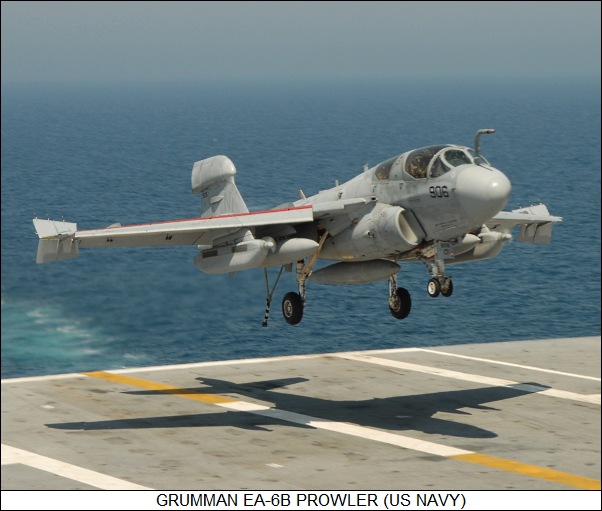
* In the mid-1950s, the US Navy began consideration of an all-weather two-seat jet attack aircraft, issuing a request for proposals (RFP) for such an aircraft in 1956. The machine would be capable of performing strike missions ranging from nuclear weapon delivery to battlefield close air support (CAS). A short take-off & landing (STOL) capability was preferred, since the Marines were to also obtain the aircraft and might need to operate it off of short airfields; in addition, STOL capability would help the aircraft operate off the smaller ESSEX-class aircraft carriers. All the major US aircraft manufacturers submitted proposals; after winnowing through them, the proposals by Douglas, Grumman, and Vought were selected as finalists, with Grumman winning the contract to develop the "A2F-1", as it was then designated, in January 1958.
The Grumman design team, headed by Lawrence M. Mead, had come up with a set of concepts, with their final selection for the "Grumman Model 128" involving a machine with moderately swept flight surfaces, featuring mid-mounted wings and a conventional tail arrangement; side-by-side seating for the two crew; and twin Pratt & Whitney (P&W) J52 non-afterburning turbojets, mounted on the fuselage under the wing roots. Given its all-weather mission, it would have an extremely sophisticated avionics suite for the era, with the aircraft being designed as a "total weapon system" -- a new concept, in which avionics systems were designed in from the start and not tacked on later.
As development proceeded, the Navy expressed interest in an electronic countermeasures (ECM) variant of the A2F-1, which Grumman agreeably drew up as the "A2F-1Q", with development proceeding on the A2F-1 with an eye to making sure that it accommodated the ECM configuration down the road. The company also came up with a variant of the A2F-1, the "Model 128B", for the Air Force that provided both reconnaissance and strike capability, but unlike the ECM development the Air Force concept never happened.
In 1959, the Navy awarded Grumman a contract for construction of eight development machines, with the first "A2F-1 Intruder", as the type had been named, performing its initial flight on 19 April 1960, with test pilot Robert Smyth at the controls. It was not fitted with full combat avionics; neither was the second development machine, which performed its first flight on 28 July 1960. Some sources refer to the development machines with the designation of "YA2F-1", but this is disputed.
Subsequent development machines brought the Intruder up towards production spec. In 1962, the military acquired a new multiservice designation system, with the A2F-1 becoming the "A-6A" and the A2F-1Q becoming the "EA-6A". By that time, Grumman was already rolling out the first batch of production A-6As, leading to manufacture of 488 in all, including the development machines, to end of production of the variant in 1970. Initial flight of an EA-6A was in 1963, with initial service deliveries of the A-6A in the same year. The US Navy and Marines were the only users of the A-6 family; the type never served with foreign air arms.
BACK_TO_TOP* The A-6A provides a useful baseline for a description of the family. The A-6A was mostly made of aircraft aluminum alloy and had a tadpole-shaped fuselage, with a broad nose to accommodate the side-by-side cockpit and the radar system to then taper back to a slender tail. Field of view through the "bugeyed" canopy was outstanding, with aircrew able to see almost straight down.
The A-6A was powered by twin P&W J52-P-8A turbojets mounted against the fuselage under the wing roots, providing a maximum of 41.4 kN (4,218 kgp / 9,300 lbf) thrust each -- the initial prototypes and early production had been powered by J52-P-6A engines with 37.8 kN (3,855 kgp / 8,500 lbf) thrust each, with operational machines later upgraded to the -8A engines. The mid-mounted wings had a quarter-chord sweep of 52 degrees. The tailplane was of all-moving configuration.
The engines were fed by simple dee-style intakes, with a small splitter plate against the fuselage forward of each intake to prevent an engine from ingesting stagnant "boundary layer" air hugging the surface of the aircraft. The original plan had been to fit the Intruder with exhausts that could pivot downward to provide better STOL performance. The first four development aircraft had the pivoting exhausts, but they weren't very useful, and all later machines had fixed exhausts, pointed slightly downward to improve lift, and also spare the tail assembly from exhaust blast. Internal fuel capacity was 8,873 liters (2,344 US gallons), with tanks in the mid-fuselage and in the wings running out to near the wingtip.
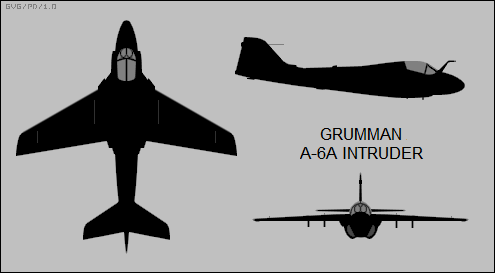
The wing arrangement was somewhat unusual. The overall planform was nothing strange, a moderately swept wing with a small "leading edge root extension" at the front of the wing root; the wings folded straight up hydraulically at about a third of the span from the wing root. There was a prominent wing fence on both the inboard and outboard wing sections, intended to prevent loss of lift due to airflow diverted down the span of the wing; pictures of the development machines suggest that only the inboard wing fence was fitted early on. The wing was thick at the root and very strong.
The flight control surface arrangement was definitely unconventional, each wing featuring:
Early on, there was also an airbrake on each side of the rear fuselage, but they caused pitch problems. Although provisions for the fuselage airbrakes were retained well into A-6A production, they were disabled in service. Later A-6A production deleted the fuselage airbrakes, and the airbrake recess in earlier production machines was generally faired over. There was nothing particularly unusual about the aircraft's tail assembly, except for a cooling air inlet in the forward tailfin fillet. All flight surfaces were hydraulically actuated.
The A-6A featured tricycle landing gear, the nose gear being fitted with twin wheels and retracting backward, while each main gear had a single wheel and retracted forward into the inboard section of the wing, the wheel pivoting 90 degrees to lie flat. There was a carrier catapult attachment on the nose gear assembly, and a stinger-type arresting hook under the rear fuselage. There was also a peculiar-looking small fitting under the tail that served as a tail bumper and a deck tiedown attachment hookup, with a fuel-dump pipe in its rear.
___________________________________________________________________
GRUMMAN A-6A INTRUDER:
___________________________________________________________________
wingspan:
16.15 meters (53 feet)
wingspan, folded:
7.67 meters (25 feet 2 inches)
wing area:
49.15 sq_meters (529 sq_feet)
length:
16.64 meters (54 feet 7 inches)
height:
4.75 meters (15 feet 7 inches)
empty weight:
11,650 kilograms (25,685 pounds)
MTO weight:
27,500 kilograms (60,625 pounds)
max speed at altitude:
1,100 KPH (680 MPH / 595 KT)
service ceiling:
12,700 meters (41,660 feet)
range, full warload:
1,625 kilometers (1,010 MI / 890 NMI)
ferry range:
4,410 kilometers (2,740 MI / 2,380 NMI)
___________________________________________________________________
The A-6A had no internal armament. External stores were carried on five external pylons -- one on the centerline, two under each inner wing section -- all of which were "wet", capable of carrying external tanks. Maximum warload consisted of six 225-kilogram (500-pound) bombs on each pylon using multiple ejector racks (MERs) for a total of 30 bombs, or a hefty load of 4,575 kilograms (15,000 pounds). Rockeye and other cluster bombs, naval mines, and even a nuclear store could also be carried. It would have been no great trouble to have qualified the Intruder to carry the AIM-9 Sidewinder heat-seeking air-to-air missile (AAM) for self-defense, since all it basically required was to wire up the missile through a stores pylon to the pilot's headphones, the missile indicating target lock with a tone. However, there's not much evidence that the A-6 ever carried AAMs for self-defense, or was even qualified for them.
In operational practice, missions seem to have generally involved a single external tank on the centerline pylon, or two tanks on underwing pylons, along with munitions. A fixed probe for probe-&-drogue refueling was fitted in front of the cockpit; sources hint that not all aircraft had the probe, but it's hard to find any pictures of an A-6A without one except for the first prototype.
The A-6A had a highly sophisticated avionics package for its era, focused on the "Digital Integrated Attack Navigation Equipment (DIANE)" system, which was built around a Norden AN/APQ-92 search radar coupled to a Naval Avionics Facility (NAF) AN/APQ-88 track radar -- quickly replaced in production by the improved NAF AN/APQ-112 -- in the bulbous nose radome. DIANE also included an inertial navigation system, an air data computer, a ballistics computer, and a Doppler navigation radar. Other aircraft avionics included radios, identification friend or foe (IFF) transponder, an automatic direction finder for homing in on navigation beacons, and a TACAN air navigation signal receiver. A radar warning receiver (RWR) was fitted, reflected by a fairing in the back of the tailfin directly above the rudder; pictures of early prototypes don't show the RWR, and it may have been fitted some time after production began.
The pilot and the bombardier-navigator (B/N) sat side by side under a canopy that slid back to open. The B/N's position was offset about a hand's width to the rear of the pilot's. They sat on Mark-Baker Mark 5 ejection seats that could provide safe ejection at any altitude from ground on up, but required a minimum speed of 185 KPH (115 MPH / 100 KT). Late production A-6As were fitted with Martin-Baker Mark 7 ejection seats with true "zero-zero" -- zero speed, zero altitude -- capability; these seats also had the ability to recline back to improve crew comfort on long flights. The aircrew got in using a step that hinged down from the engine nacelle on each side of the aircraft.
* With war heating in Southeast Asia in the early 1960s, the Intruder quickly saw action. The A-6A performed its first combat sorties over Vietnam on 1 July 1965, with aircraft from the carrier USS INDEPENDENCE pounding targets south of Hanoi. There were initial teething problems in combat, one particularly ugly one resulting in the loss of three A-6As when their bombs detonated immediately after release. The problem turned out to be due to the bomb rack arrangement, with the bombs colliding after drop, and was quickly fixed.
Nobody would have ever described the Intruder as a pretty aircraft, but the A-6A proved a very valuable resource, able to perform accurate strikes in night and bad weather. It proved to be an excellent ride at low level, being compared to a "Cadillac". The only major problem was that the DIANE system's reliability was very poor, meaning the aircraft spent a lot of time in the shop, with operational availability rates running from half to a third of the Intruder force. In night operations, combat losses were low; they were substantially higher for the daytime battlefield close-support role, which was better served by the old Douglas A-1 Skyraider piston aircraft in any case.
Another difficulty with the sophistication of the A-6A was that it presented a steep learning curve to the B/N. For most of the early years, the B/Ns got their early flight training on Douglas TA-3B Skywarrior aircraft, but the TA-3B's radar system was not comparable to that of the A-6A and so the training on the TA-3B was of limited usefulness. Recognizing the problem, the Navy put in motion an effort to acquire a specialized systems trainer for the A-6A, slapping the A-6A nose and its major combat avionics systems onto a Gulfstream I twin-turboprop executive aircraft. The first "TC-4C Academe", as the result was named, performed its initial flight in 1967, with nine Academes built in all.
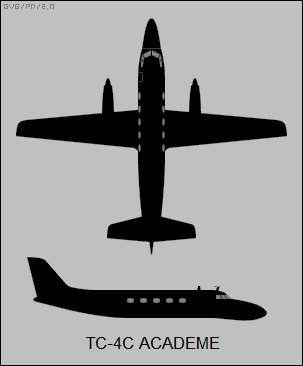
The A-6A served throughout the Vietnam conflict. Normal colors were typical US Navy light gray on top and white on the bottom, though some were experimentally painted dark green on top for a time. In 1966, an update program was put into motion to update the A-6A's AN/APQ-92 and AN/APQ-112 radar systems, as well as fit a more durable and effective nose radome.
By the time the Americans effectively withdrew from Vietnam in 1972, the Navy and Marines had lost 67 A-6As in combat and 11 in accidents. The A-6A as such didn't long survive the war, the fleet being used as a "feedstock" for conversion into other Intruder variants, as discussed below, with the conversion process begun well before the end of the war.
BACK_TO_TOP* Development of the EA-6A ECM aircraft followed that of the A-6A, with two early production A-6As converted to EA-6A prototypes, the first performing its initial flight on 26 April 1963. The "Electric Intruder", as it was formally known, looked very much like the A-6A, the only clear visible difference being a prominent "football" fairing on the top of the tailfin for the AN/ALQ-85 signal surveillance / receiver system. The wingtip airbrakes were also deleted in order to mount hoop antennas under the wingtips; the EA-6A retained functional fuselage airbrakes. The forward fuselage was stretched by about 20 centimeters (8 inches) to allow fit of the ECM gear.
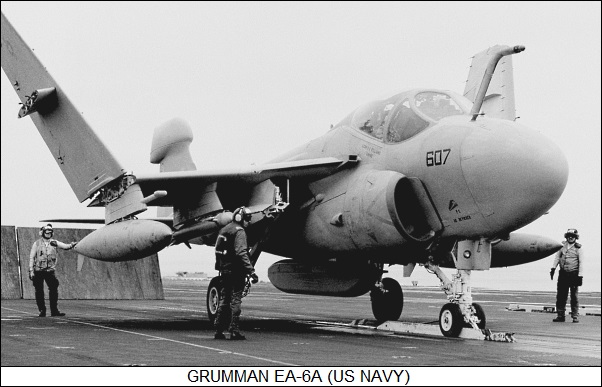
The EA-6A could carry radio frequency (RF) jammer pods, chaff pods, or fuel tanks on its underwing pylons -- an extra pylon was fitted outside the wing fold, capable of hauling light stores like chaff dispensers, giving a total of seven pylons. In principle, it could also carry offensive stores, it had a rudimentary attack system, but it rarely if ever did so in practice. The ECM systems were operated by an "electronics countermeasures officer (ECMO)" -- a job description historically known as a "crow" or "raven" for some obscure reason -- who doubled as navigator.
___________________________________________________________________
GRUMMAN EA-6A ELECTRIC INTRUDER:
___________________________________________________________________
wingspan:
16.15 meters (53 feet)
wingspan, folded:
7.67 meters (25 feet 2 inches)
wing area:
49.15 sq_meters (529 sq_feet)
length:
16.64 meters (54 feet 7 inches)
height:
4.95 meters (16 feet 3 inches)
empty weight:
12,595 kilograms (27,770 pounds)
MTO weight:
25,630 kilograms (56,500 pounds)
max speed at altitude:
1,000 KPH (620 MPH / 540 KT)
service ceiling:
12,700 meters (41,660 feet)
range, full warload:
1,625 kilometers (1,010 MI / 890 NMI)
ferry range:
4,100 kilometers (2,545 MI / 2,215 NMI)
___________________________________________________________________
Not counting the two prototypes, a total of 25 EA-6As was built, including 10 rebuilds of A-6As and 15 new-production machines, the first being delivered to the Marines in 1965 and the last being rolled out in 1969. They replaced the elderly and antiquated Douglas EF-10B Skyknight in combat, providing ECM to protect strike packages. They typically flew with two drop tanks, three jammer pods, and two chaff dispenser pods. The EA-6As only saw combat in Vietnam with the Marines. At least two EA-6As were lost in Vietnam, one disappearing on an operational sortie along with its crew; the other being destroyed in an accident, with the crew ejecting safely.
After the conflict, the EA-6As remained in service with both the Marines and Navy, it seems increasingly in the "electronic aggressor" role, used to baffle the electronic systems of participants in military training exercises. The EA-6As were given sets of upgrades to keep them useful.
* The EA-6A was an ECM platform, intended to blind and confuse adversary defenses. There was another approach for dealing with adversary defenses, namely to destroy them, with that mission given the melodramatic name of "Iron Hand", though later it would be given the blander designation of "suppression of enemy air defenses (SEAD)". As the war dragged on in Southeast Asia, the Navy became increasingly fond of the idea of taking on anti-aircraft defense sites, and so a program was set up to covert A-6As into specialized SEAD aircraft, to be designated "A-6B".
A total of 19 conversions was performed from 1967 into 1970. The A-6Bs were stripped of the primary attack kit of the A-6A and fitted with what was generally known at the time as a "radar homing and warning system (RHAWS)" designed to locate and characterize radars from air-defense sites. Once the radars were targeted, the A-6B would then take them out using its load of "anti-radiation (radar) missiles (ARM)", with the aircraft usually carrying two AGM-45 Shrike ARMs -- a derivative of the AIM-7 Sparrow AAM -- and two AGM-78 Standard ARMs AKA STARMs -- a much bigger and more capable weapon, a modification of the shipboard Standard surface-to-air missile (SAM). With the radars out, other strike aircraft would plaster the air-defense site with high-explosive and cluster bombs.
After delivery of the first ten A-6Bs, three were built using an improved RHAWS, the "Passive Angle Tracking ARM (PAT/ARM)" system developed by the Applied Physics Laboratory of the Johns Hopkins University, with the PAT/ARM providing better support for the AGM-78 STARM. The last six A-6Bs were fitted with the further improved IBM "Target Identification Acquisition System (TIAS)". At least some of the versions of the A-6B had an antenna protruding from the wing leading edge directly over each outer stores pylon, providing a recognition feature, though it is unclear if this arrangement was common to all three A-6B subvariants. The SEAD mission was necessarily dangerous since it involved looking for trouble instead of avoiding it, and five A-6Bs were lost in combat.
* A batch of A-6As was modified to a highly specialized configuration to perform night attacks on truck convoys moving down the Ho Chi Minh trail through Laos and Cambodia, with this variant being designated the "A-6C". It was related to a program named "Trails Roads Interdiction Multisensor (TRIM)" program, in which Lockheed Neptune ocean patrol aircraft were fitted with a sensor package to similarly perform attacks on the trail. The TRIM system included a forward-looking infrared (FLIR) camera, a low light level television (LLTV) camera, and a "Black Crow" system that could in principle zero in on the radio emissions of the ignition system of truck engines.
An A-6A was modified as a prototype, the "NA-6A", featuring the sensors carried in underwing pods, this machine performing its initial flights in late 1968. A dozen A-6As were converted to the A-6C configuration during 1970, with these machines including the sensor package in a reasonably neat fairing under the rear of the belly. Not much is known about the career of the A-6Cs, though apparently the sensors were "draggy" and seriously cut into performance. Much of the high tech used in the Vietnam War was leading-edge and unreliable; it might be guessed the A-6Cs spent a fair amount of time in the shop. One A-6C was lost in combat. It appears the exercise was not regarded as a success.
* The Navy had tinkered early on with using the A-6A as an inflight refueling tanker, carrying a "buddy tanking" pod on a stores pylon, but at the time it wasn't seen as a particular good platform for the task -- it could carry a large fuel load, but it was relatively expensive to operate, and the A-6A was needed for the strike role. Other platforms could do the tanker job.
In 1968, however, the Navy reconsidered use of the Intruder as a tanker. There were plenty of A-6As in service, and it made sense to spare some of them as tankers. The first "KA-6D" tanker performed its initial flight on 16 April 1970, leading to a total of 90 conversions, all of the machines having started life as A-6As -- though a dozen of these A-6As had been previously converted to A-6Es, see below. The conversions involved extensive reconditioning, and refit with new wiring; most of the complicated attack avionics were removed, though in principle the KA-6D was still capable of performing daylight strikes. It never did.
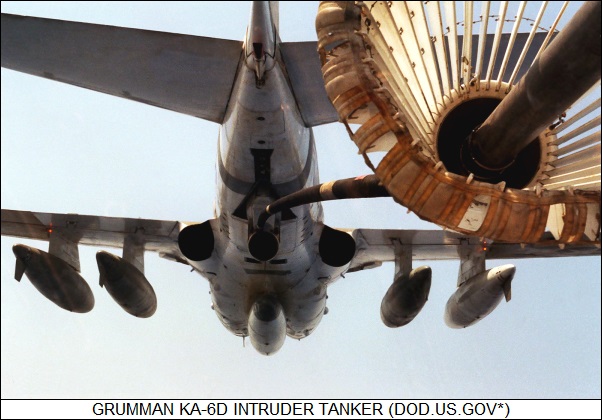
The KA-6D had a built-in hose-drum unit (HDU), installed under the rear fuselage. In service, the KA-6D usually flew with four or even five external tanks. It also sometimes carried a buddy tanking pod, either for backup or just for ferrying it to another base. Since a KA-6D couldn't land on a carrier if the hose got stuck in its extended position, an explosive cutter system was fitted to get rid of it if necessary.
BACK_TO_TOP* Even as the A-6A was being heavily exercised in Southeast Asia, from 1966 Grumman was working on a substantially improved variant, the "A-6E", with the first prototype converted from an A-6A and performing its first flight in its revised configuration on 27 February 1970. Trials going well, A-6A production was ended in December 1970, with Grumman beginning to roll out A-6Es in the fall of 1971.
The A-6E was externally all but identical to the A-6A; it did have new J52-P-8B engines, but they were just a minor refinement of the old -8A engines and had the same thrust ratings. The primary improvements were in avionics, primarily a new solid-state AN/APQ-148 solid-state radar system and an AN/ASQ-133 solid-state digital computer system. An AN/ALQ-100 jammer system was fitted, with an antenna in a slight but noticeable extension of the outer LERX on each wing, providing a recognition feature. Apparently the AN/ALQ-100 was also carried on some other Prowler variants, such as the EA-6A, though the antennas weren't fitted in the LERXs.
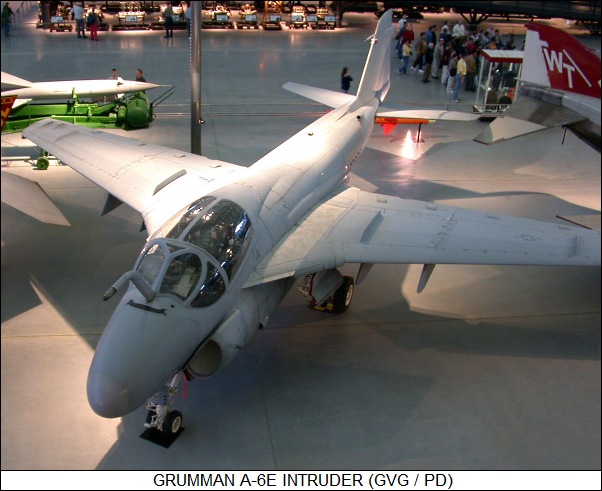
A total of 240 A-6Es was built new, with 205 additional conversions from earlier variants, primarily A-6As, though all the surviving A-6Bs and A-6Cs ended up being A-6Es -- as noted above, a dozen A-6As that had been converted to A-6Es were then converted to KA-6Ds. The A-6Es were consecutively upgraded in service:
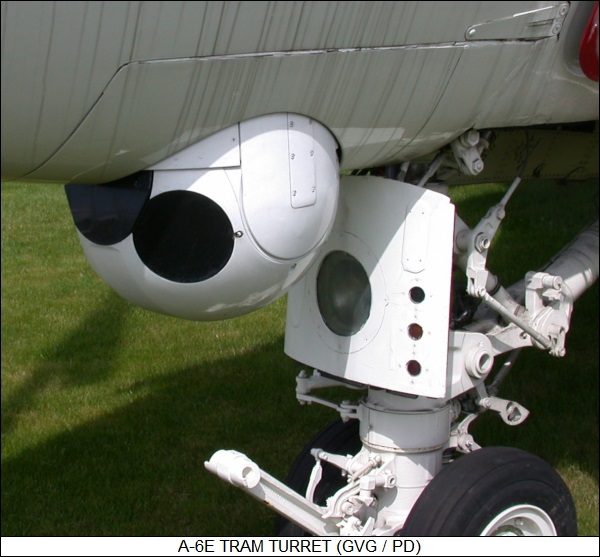
* From the mid-1980s, there was work on a follow-on to the A-6E, originally just designated the "A-6E Upgrade" but then later the "A-6F". It was to have the new composite wing, completely modernized avionics, and General Electric GE F404 bypass turbojets, which were non-afterburning variants of the F404 that powered the McDonnell-Douglas F/A-18 Hornet fighter. Three demonstrators for the "Intruder II", as it was known, were modified from A-6Es, the first performing its initial flight in its new configuration on 26 August 1987.
However, the A-6F program was canceled the next year, 1988, with two more demonstrators in the pipeline never being flown. The Navy had moved on to the secret "stealthy" A-12 program, which was canceled itself in 1991 after the development effort became clearly "snakebitten". Ultimately, the Navy would focus on the Boeing F/A-18E/F Super Hornet as the "A-6 replacement". There was also talk in the wake of the cancellation of the A-6F of an "A-6G" with the new avionics while retaining the old J52 engines, but the A-6G never got out of the "talk" stage. Some sources claim that the Navy's failure to acquire the A-6G was a major blunder -- but what's done is done.
BACK_TO_TOP* The A-6E was an important US strike asset in the post-Vietnam era. Its first combat action in this period was in Operation URGENT FURY, the US occupation of the Caribbean island of Grenada in late October 1983, with A-6Es performing air support for US ground forces. This action was quickly followed by retaliatory strikes performed on Syrian targets on 4 December 1983 as a consequence of the devastating suicide bombing of the US Marine barracks in Beirut on 23 October 1983. The strikes were a fiasco, accomplishing little except for the loss to Syrian air defenses of a Vought A-7 strike fighter, the pilot being recovered, and an A-6E, one of the aircrew being killed and the other held prisoner by the Syrians for a short time.
* Things went better for the Intruder in later interventions. US President Ronald Reagan regarded Libyan dictator Moammar Qaddafi as a particular menace to world peace, Qaddafi being a prominent backer of international terrorist movements. When Qaddafi declared the Gulf of Sidra off the Libyan coast a "zone of death" for foreign ship movements, Reagan, who did not shrink from military confrontations, ordered the US Navy into the area as a heavily-armed "freedom of navigation" exercise. On 24 March 1986, after the Libyans launched SAMs against American aircraft, the US Navy hit back, with A-6Es hammering a Libyan corvette with Harpoon missiles -- the first use of the Harpoon in combat -- to then sink it with bombs, and then taking out a Libyan air-defense site with HARMs. The next day, 25 March, A-6Es sank another Libyan vessel, damaged a few more, and pounded SAM sites.
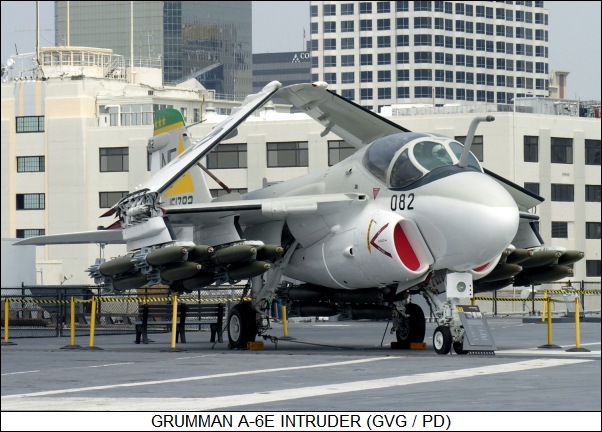
In retaliation, on 5 April a Berlin nightclub where US servicemen liked to hang out was bombed, with a US soldier and a civilian killed along with hundreds injured. US intelligence confirmed it as a Libyan-directed act of terror; in response, Reagan ordered comprehensive strikes by Air Force and Navy jets against Libya. The attack took place on the night of 14:15 April under Operation EL DORADO CANYON, with A-6Es playing a prominent role in the attacks. The operation was well planned, well executed, and inflicted considerable damage on the Libyans. There were hopes it would destabilize Qaddafi's regime; it didn't, but it apparently led Qaddafi to gradually distance himself from terrorist groups. It certainly did much to enhance Reagan's appeal to the public back home, demonstrating his instinctive grasp of military theater.
The next US military operation in which A-6Es were involved was the Persian Gulf tanker escort operations of 1987:1988. The war between Iraq and Iran had been sputtering on violently since 1980, with attacks on oil tankers in the gulf gradually ramping up. The US finally intervened to help protect the ships of Gulf allies from attacks, with A-6Es participating in intermittent exchanges of fire with Iranian forces. The Iran-Iraq War finally fizzled out in a stalemate in 1988.
* The war had left the regime of Iraqi dictator Saddam Hussein in a difficult position, with antagonisms left over towards Kuwait, and in 1990 the Iraqis invaded and conquered Kuwait. A US-led coalition ordered the Iraqis to get out; they didn't, and on 17 January 1991 a countermove, Operation DESERT STORM, started off with an overwhelming air assault. After a month of pounding, ground forces went into Kuwait on 25 February, sending Iraqi forces fleeing home in disarray. The A-6E played an important role in the air war, with three shot down, one damaged beyond repair, and one lost in a noncombat accident.
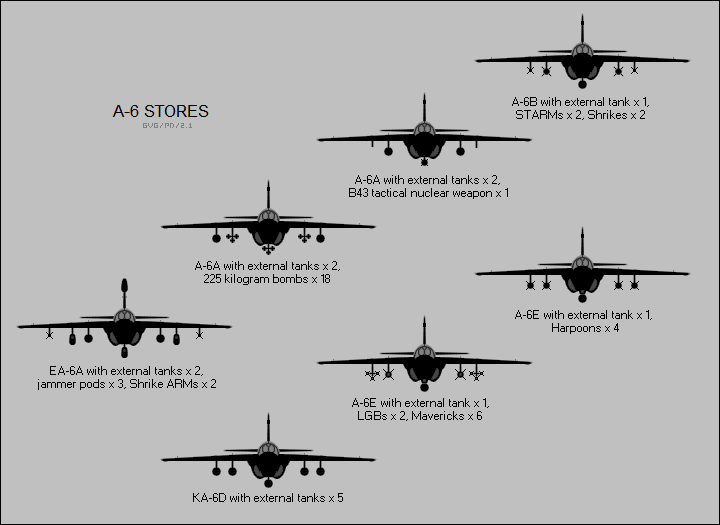
One of the A-6E's most significant roles in the war was as an aerial minelayer, closing off Iraqi shipping channels. This was the last time the US Navy performed the combat mine-laying mission. At least one A-6E was painted with a desert disruptive camouflage pattern topside during the conflict. The First Gulf War was the swan song of the A-6E, with the type beginning its gradual phaseout almost immediately afterward. It was out of service by 1996. A number of Intruders ended their lives by being sunk in the Atlantic off the coast of northern Florida to serve as the core of an artificial coral reef.
BACK_TO_TOP* From 1964, Grumman worked on an improved ECM version of the A-6, the core of which was to be the AN/ALQ-99 Tactical Jammer System (TJS) being developed by Cutler-Hammer. The AN/ALQ-99's primary receiving antennas were to be housed in a pod on top of the tailfin, like that on the EA-6A, with additional antennas on the side of the tailfin. Other jammer gear was to be carried on the underwing pylons.
The extended ECM capabilities were too much for one ECMO, so the crew was increased to four, including a pilot and three ECMOs, sitting in a 2x2 arrangement on Martin-Baker Mark 7 ejection seats, with the front-seat ECMO doubling as a navigator. There were separate back-hinged clamshell canopies for each of the two rows of seats. The canopies were coated with a thin gold film to protect the crew from the powerful emissions produced by the aircraft's jammer systems.
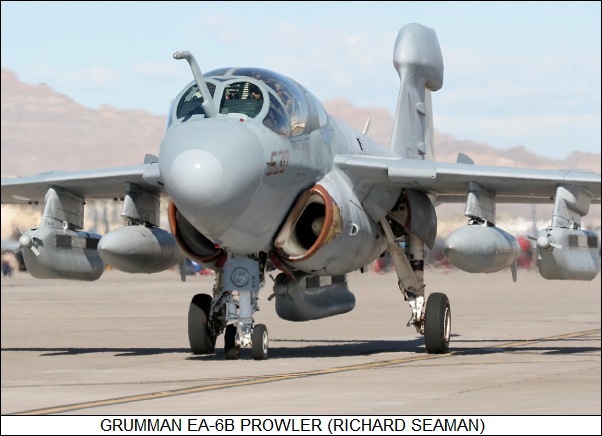
The two extra crew meant a fuselage stretch of 1.37 meters (4 feet 6 inches), and the additional weight led to reinforced wings and landing gear -- the internal fuel capacity was also increased. The LERX were extended, possibly to maintain flight trim. An AN/APQ-129 radar was fitted in the nose to help support attacks with Shrikes ARMs or other munitions, with an AN/APN-153 Doppler navigation radar fitted as well, along with an AN/ALQ-100 defensive jammer system.
Three A-6As were modified as initial prototypes, with the first flying in its new form on 25 May 1968. The first production EA-6B performed its first flight in November 1970, with service deliveries beginning the next year, 1971. Initial production machines had J52-P-8A engines, with later production featuring uprated J52-P-408 engines providing 49.8 kN (5,080 kgp / 11,200 lbf) thrust each, and most early machines retrofitted with these engines.
___________________________________________________________________
GRUMMAN EA-6B PROWLER:
___________________________________________________________________
wingspan:
16.15 meters (53 feet)
wingspan, folded:
7.67 meters (25 feet 2 inches)
wing area:
49.15 sq_meters (529 sq_feet)
length:
18.24 meters (59 feet 10 inches)
height:
4.95 meters (16 feet 3 inches)
empty weight:
14,320 kilograms (31,570 pounds)
MTO weight:
29,485 kilograms (65,000 pounds)
max speed at altitude:
1,000 KPH (620 MPH / 540 KT)
service ceiling:
12,550 meters (41,200 feet)
operational range:
1,760 kilometers (1,100 MI / 955 NMI)
ferry range:
3,255 kilometers (2,020 MI / 1,755 NMI)
___________________________________________________________________
The EA-6Bs were regarded as sufficiently different from other Intruder variants to be given a new name: "Prowler". They were available for combat operations over Southeast Asia in the very last months of the US involvement in the Vietnam War, suffering no losses. 170 new-build Prowlers were manufactured up to end of production in 1991.
BACK_TO_TOP* The EA-6B fleet was successively upgraded to improved configurations. Deliveries of the "Expanded Capability (EXCAP)" configuration began in 1973, with most earlier Prowlers upgraded to this configuration as well -- as would happen with all later Prowler upgrades. The major improvement with EXCAP was support for the AN/ALQ-99 series of jammer pods, which supported eight radio bands instead of four as with their predecessors. EXCAP added several other new features:
The "Improved Capability (ICAP)" configuration was introduced in 1975. It featured:
The "ICAP II" configuration followed ICAP from 1980. ICAP II offered:
Late production ICAP II machines featured an updated radio set. The intent after ICAP II was to move on to the "Advanced Capability (AVCAP)" configuration, which would have not merely featured avionics improvements but also airframe improvements, particularly uprated engines. However, although a demonstrator was flown, AVCAP was canceled in the mid-1990s.
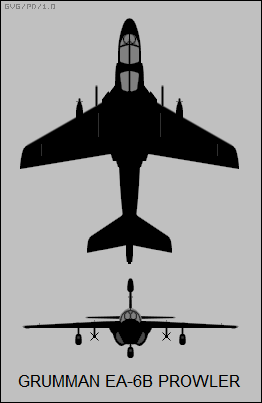
The Navy focused on less ambitious upgrades, initially with the "Block 89A" upgrade, which was to provide a uniform avionics kit for the Prowler fleet, including a GPS receiver, a new electronic flight information system (EFIS), and improvements to the computer and radio systems. The Block 89A led the way to the "ICAP III" upgrade.
The main focus of ICAP-III was to provide greater integration of the Prowler's electronic systems. The three ECMOs were provided with new color displays; the pilot got a color display as well, though a smaller one. ICAP-III gave faster response to electronic threats, with the Litton LR-700 electronics support measures (ESM) system, featuring antennas on the aircraft's nose, tail, and wingtips working in conjunction with the GPS receiver system to pinpoint the location of those threats with greater accuracy, allowing a more effective attack with HARMs or other weapons.
The core of ICAP-III was the "AN/ALQ-218" digital receiver system, replacing the AN/ALQ-99 system, with the AN/ALQ-218 featuring a "threat library" to characterize various threats and provide the most efficient jamming response. ICAP-III was capable of "following" jamming, or jamming at new frequencies as the threat emitter changed frequency -- while still jamming the original frequencies. A digital datalink was also added to allow the Prowler to share inputs with other platforms.
The first ICAP-III Prowler performed its initial flight in 2001, with production initiated in 2003 and initial redeliveries in 2005. Upgrades were complete in 2010. Along with ICAP-III, the Navy implemented other improvements for the Prowler fleet, for example night-vision goggle (NVG) compatibility, adding support for NVGs plus modification of cockpit and exterior lighting.
* The EA-6B was a prominent participant in American conflicts from the end of the Vietnam War. There were plans to downsize the Prowler forces from the mid-1990s, but the US Air Force phased out their General Dynamics EF-111A "Spark Vark" fleet of jammer aircraft in 1998, leaving the EA-6B as the "only game in town" for US ECM needs. The Prowler force was maintained to provide support for the Air Force along with the Navy and Marines.
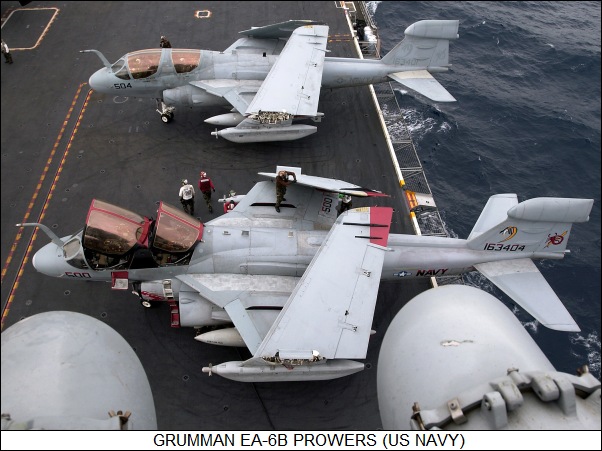
The Prowler was replaced in Navy service by an ECM derivative of the Boeing F/A-18E/F Super Hornet, the "EA-18G Growler", which uses the ICAP-III avionics suite. The last service flight of a Navy Prowler was on 27 June 2015.
Marine Prowlers were still in action in 2018, flying missions out of Qatar to jam communications of Islamist insurgents in Syria -- but that was the end of it, the Prowler being retired in 2019. The Marines are thinking of replacing it with a vertical take-off drone that can operate off assault ships, to conduct electronic warfare, early warning, surveillance, and communications relay missions. They also would like the drone to carry light guided weapons to deal with "time-critical targets" -- that is, that have to be engaged when spotted, or they'll get away -- and possibly a light cargo load as a secondary mission. In the meantime, the Marines will rely on Navy Growlers for the ECM mission.
* The list below summarizes A-6 variants and production:
A total of 913 A-6s was manufactured in all.
BACK_TO_TOP* In the early 1960s, Grumman proposed a single-seat day combat version of the Intruder in response to a Navy requirement for a new strike aircraft. The Grumman "G-128-12" was nothing more than an A-6A with a new forward fuselage, featuring the single-seat cockpit and a simpler radar system, plus twin 20-millimeter cannon firing out the nose. It had pretty much the same stores capabilities as the A-6A, though it was envisioned as carrying Sidewinder and even Sparrow AAMs for self-defense, implying a radar system with Sparrow support. The Navy selected the Vought A-7 instead.
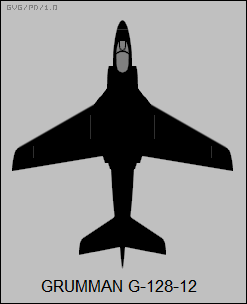
I recall when I was a teenager back in Spokane, Washington in the late 1960s or early 1970s seeing an A-6 performing simulated strike attacks over the city. It's a vivid memory, but I found it a bit puzzling -- we had Air Force facilities near town, but no Navy or Marine air stations in the immediate area. On mentioning this in an earlier revision of this document, I was informed that the A-6 was from Naval Air Station Whidbey Island in Puget Sound, in the Pacific coastal regions of Washington State. Spokane was a relatively short hop from NAS Whidbey, and useful for training purposes. For practice with live munitions, Intruders usually went to the range at Boardman in eastern Oregon.
* Sources include:
* Revision history:
v1.0.0 / 01 may 10 v1.0.1 / 01 aug 11 / Review & polish, added G-128-12. v1.0.2 / 01 jul 13 / Review & polish. v1.0.3 / 01 jun 15 / Changed "WSO" to "B/N". v1.0.4 / 01 may 17 / Review & polish. v1.0.5 / 01 apr 19 / Review & polish. v1.0.6 / 01 feb 21 / Review & polish. v1.0.7 / 01 dec 22 / Review & polish. v1.0.8 / 01 sep 24 / Review & polish.BACK_TO_TOP
